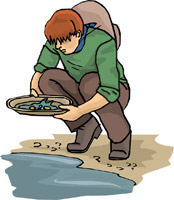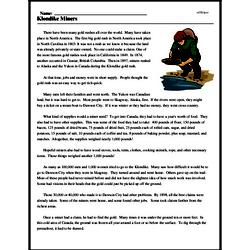Klondike Miners
Yukon Discovery Day
Reading Comprehension for August 21
There have been many gold rushes all over the world. Many have taken place in North America. The first big gold rush in North America took place in North Carolina in 1803. It was not a rush as we know it because the land was already privately or state owned. No one could stake a claim. One of the most famous gold rushes took place in California in 1849. In 1874, another occurred in Cassiar, British Columbia. Then in 1897, miners rushed to Alaska and the Yukon in Canada during the Klondike gold rush.
At that time, jobs and money were in short supply. People thought the gold rush was an easy way to get rich quick.
Many men left their families and went north. The Yukon was Canadian land, but it was hard to get to. Most people went to Skagway, Alaska, first. If the rivers were open, they might buy a ticket on a steam boat to Dawson City. If it was winter or they had no money, they went cross country.
What kind of supplies would a miner need? To get into Canada, they had to have a year's worth of food. They also had to have other supplies. This was some of the food they had to take: 400 pounds of flour, 150 pounds of bacon, 125 pounds of dried beans, 75 pounds of dried fruit, 25 pounds each of rolled oats, sugar, and dried potatoes, 15 pounds of salt, 10 pounds each of coffee and tea, 8 pounds of baking powder, plus soap, mustard, and matches. Altogether, the supplies weighed nearly 1,000 pounds!
Hopeful miners also had to have wood stoves, tools, tents, clothes, cooking utensils, rope, and other necessary items. Those things weighed another 1,000 pounds!




